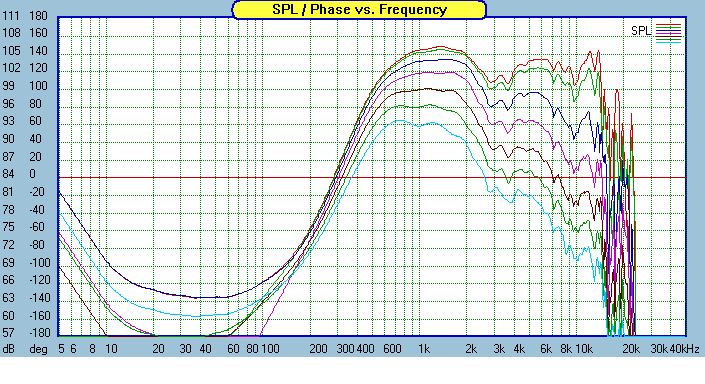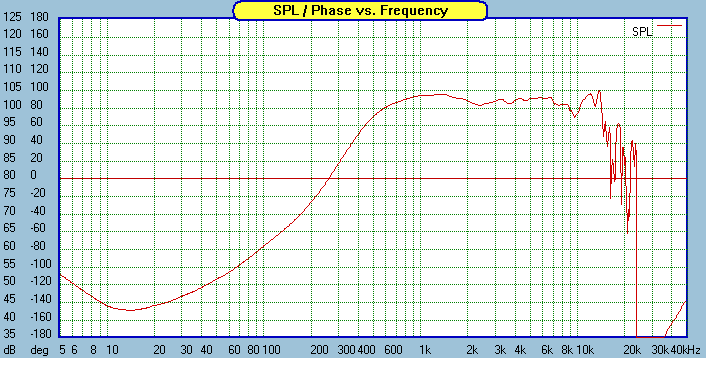To sum up, the OT12 is a rear-vented horn with a throat approximately 8.5~9" high (the top and bottom are circles that follow the outline of the cone) and 4" wide. The mouth is 15" high by 22" wide, and the horn portion is about 10" deep. If I'm reading the tea leaves correctly, it is a short conical horn that covers the range from about 200 to 1600 Hz, and uses the broad peak of the Helmholtz resonator of the rear chamber to fill in the range from 100 to 200 Hz.
..
A scaled-up version of Michael's 2-dimensional horn wouldn't be all that different than the OT12, which has most of the horn expansion in the horizontal plane. The OT12 is a simple, straight conical, while Michael's has the distinctive JMMLC contour. Choose a high enough T ratio, and the JMMLC starts to have the slow rolloff characteristic of a conical, with presumably less diffraction at the mouth, thanks to the inherent round-over.
Not thinking I'm a dedicated horn expert either - as I approach the topic solely from the side of diffraction alignment and sound field consistency – I did a BEM simu for you for some further exercises in reading the tea leaves...



The plots show a simu of the OmniTop 12 in horizontal cut – with an arbitrary 12" cone used.
The polars are talken at 1m distance at 0 10 20 30 40deg
As AxiDriver can not simulate rectangular shapes (there is a Beta that should do – but I haven't tried) results may be taken with a grain of salt.
The only conclusion I can draw from above simus are that it seems to be a save bet that Bill's design is *not* dominated by the horn contour (quite in contrary to the Dipole Horn of mine you are referring to).
At least if you compare with the measurements and also with Bill's simu at
http://www.diyaudio.com/forums/multi-way/100392-beyond-ariel-127.html#post1956469
So I'm rather sceptical if there are benefits if you try to improve with a JMLC contour...
For the frequency range of your interest it would become a pretty big animal anyway – if done "right" (JMLC full size horn).
Michael
Last edited:
Sorry Peter
I should have been more detailed for the ones not familiar with AxiDriver.
The plots show *two* circular symmetric horns simulated with the contour of the horizontal and the vertical cut of the OT12 respectively.
So its not - as one may assume from my poor wording - a vertical and horizontal cut from the *same* simu (AxiDriver only alows for axisymmetric contours to be simulated).
This was of a lesser problem than I actually though - when I simulated my cylinder wave horn - so it might do here as well .
One would have to impose the horizontal and vertical figures one over the other - more or less ...
- more or less ...
Michael
I should have been more detailed for the ones not familiar with AxiDriver.
The plots show *two* circular symmetric horns simulated with the contour of the horizontal and the vertical cut of the OT12 respectively.
So its not - as one may assume from my poor wording - a vertical and horizontal cut from the *same* simu (AxiDriver only alows for axisymmetric contours to be simulated).
This was of a lesser problem than I actually though - when I simulated my cylinder wave horn - so it might do here as well .
One would have to impose the horizontal and vertical figures one over the other
Michael
Last edited:
The only conclusion I can draw from above simus are that it seems to be a save bet that Bill's design is *not* dominated by the horn contour (quite in contrary to the Dipole Horn of mine you are referring to).
So... no HOM and nasty diffraction effects in this design? The pressure plots look quite.. well.. homogeneous..
So... no HOM and nasty diffraction effects in this design? The pressure plots look quite.. well.. homogeneous..
Actually, HOM I see as a chapter that is closed.
As for "nasty diffraction effects" this is not related to horn contours only IMO.
Quite in contrary - basically all and everything we do in audio is highly related to the topic of "nasty diffraction".
I opposition to most, I love to see the challenge being *not* avoiding diffraction – which to me is a silly thing, as "diffraction" *always* occurs in all but very rare and academic cases.
Even more – "diffraction" usually is always the same – given any piston like speaker radiating into 4PI after some distance – its simply 180 towards each side - to finally fill the whole room/space available.
The really interesting and challenging point is to *align* diffraction – meaning to set the points of diffraction in space so as to conserve a maximum of sound field coherence.
This is why I brought up the term and idea of "min phase horns" ...
(well, some others help in this...)
Michael
Last edited:
And a beautiful sunset too ...
As you can probably tell, I'm happy to have a sunny day after the drama of the snowstorm. After 30 years in the gloomy winters of the Pacific Northwest (similar to the weather in Northern Europe), I'm surprised how fast I got used to the 330 days of brilliant, high-altitude sun we get in Colorado. Even a few days without and Karna and I start to feel sort of mopey and down, then cheery again when it comes out. Silly enough, but the mood swings are real. Now I know why Northwesterners are always sitting in their coffeeshops all winter long.
Right now listening to great Charlie Haden / Pat Metheny "Beyond the Missouri Sky "
Missouri Sky: Pat Metheny
Sort of same mood in the pix and possibly also in the music ....
Michael
Attachments
And a last moody one - I took some weeks ago on a journey we enjoyed very much..

http://www.kinotechnik.edis.at/pages/diyaudio/ESL/P9100298.JPG
No photoshop needed - colors exactly match my memory - what a dawn this was !
Michael
http://www.kinotechnik.edis.at/pages/diyaudio/ESL/P9100298.JPG
No photoshop needed - colors exactly match my memory - what a dawn this was !
Michael
Last edited:
Michael, you might try modeling Volvotreter's midbass horn:
Current System
Download Section
Also, model without a baffle, in that most systems this large have no baffle.
Current System
Download Section
Also, model without a baffle, in that most systems this large have no baffle.
Michael, you might try modeling Volvotreter's midbass horn:
Current System
Download Section
Also, model without a baffle, in that most systems this large have no baffle.
Thanx for the links Scott.
I already was looking in tapped horns myself for a sub (Tom Danley's SPUD for example and also some tall ones), they are very tempting for the +/-20Hz region - but I'm not ready yet to go this route.
Maybe after a while...
My modeling of horns in infinite baffle is out of pure lazyness as it takes considerable less time. Also as you begin to model 4Pi space you start to model a *real* room to some degree - may it fit your positioning (back wall distance) or not.
For a quick check IB modeling should do nevertheless.
Michael
Last edited:
I don't even want to think about the cost of these drivers..
MAXONIC | Sibatech, inc. High-quality Audio Equipment from Japan
MAXONIC | Sibatech, inc. High-quality Audio Equipment from Japan
I think Maxonic should adjust their font style a little!
At first glance I read "Moronic" and thought I was looking at some sort of Halloween joke, what with the Gothic style, and having just watched "Young Frankenstein" by Mel Brooks.
It is a little late.
...then I read further and encountered some of the most tortured copy I've ever seen, describing the design of Soloist speakers:
http://www.sibatech.co.jp/soloist/about.html
Ouch!
At first glance I read "Moronic" and thought I was looking at some sort of Halloween joke, what with the Gothic style, and having just watched "Young Frankenstein" by Mel Brooks.
It is a little late.
...then I read further and encountered some of the most tortured copy I've ever seen, describing the design of Soloist speakers:
http://www.sibatech.co.jp/soloist/about.html
Ouch!
Last edited:
some of the most tortured copy I've ever seen,
LOL! " ..generating pure sound free of mannerism" I like that one. =)
Ariel and active crossovers?
I searched a bit and it seems nobody adapted an active crossover for the Ariel - am I missing something obvious?
To adapt the passive crossover to an active one seems worth pursuing IMHO. After all it's a 2-way design that does not require too many power amps ;-))
Any links or pointers or opinions would be great!
Have fun, Hannes
I searched a bit and it seems nobody adapted an active crossover for the Ariel - am I missing something obvious?
To adapt the passive crossover to an active one seems worth pursuing IMHO. After all it's a 2-way design that does not require too many power amps ;-))
Any links or pointers or opinions would be great!
Have fun, Hannes
Wish Srajan would measure in-room response. Wonder if the "amorphous and neutered" sound from the yamamotos is actually just flat... though again without measurements who knows.
I'd like that as well, particularly considering his latest "listening room".
I suspect however that the diffuse imaging is largely down to side-wall reflections. I've personally found that side-wall reflections form a *directive* design are far worse than from something that approaches an omni-pattern with a relatively small radiating source. This seems counter-intuitive, but that's been my experience.
Lynn,
- That broad response hole between 2K & 4K just isn't acceptable .

- Has GPA offered you a solution for the driver that didn't measure correctly ( ie; something like a replacement diaphragm ) ?
- From my limited perspective, it looks like a possible 50% rejection rate for this product.
- It doesn't bode well for GPA if they've inherited Altecs' well known QC problems from the past .
<> cheers
- That broad response hole between 2K & 4K just isn't acceptable .

Lynn Olson said:Augerpro was kind enough to measure the second GPA 288 on the AH425 horn - and as you can see, it measures differently. (All measurements at 2 meters with no equalization.) This measurement is much closer to Bjorn Kolbrek's measurement of his Altec 288C on his AH425 horn, so the previous measurements of the GPA 288 may indicate a problem with that particular driver.

I'm no horn expert - but I'd guess the phase plug might be misaligned with respect to the diaphragm, producing the broad rise centered around 1.5 kHz and the two sharp nulls at 2.8 and 3.6 kHz. The first driver has a smoother characteristic in the 1~10 kHz region, with the diaphragm breakup region above 10 kHz looking very similar.
- Has GPA offered you a solution for the driver that didn't measure correctly ( ie; something like a replacement diaphragm ) ?
- From my limited perspective, it looks like a possible 50% rejection rate for this product.
- It doesn't bode well for GPA if they've inherited Altecs' well known QC problems from the past .
<> cheers
Lynn,
- That broad response hole between 2K & 4K just isn't acceptable .

- Has GPA offered you a solution for the driver that didn't measure correctly ( ie; something like a replacement diaphragm ) ?
- From my limited perspective, it looks like a possible 50% rejection rate for this product.
- It doesn't bode well for GPA if they've inherited Altecs' well known QC problems from the past .
<> cheers
If you look closely at the 2 curves you'll notice that the scale isn't the same.
The 2 drivers are broadly comparable *except* for the increase in output below 2.5 kHz (and a mild 1 db difference from 2.5 to 4).
In other words, the rear volume (or apparent rear volume) of one compression driver is *smaller* than the other. That driver with the "smaller" volume has increased spl, below 2.5 kHz and it's resonance higher with a 2nd order acoustic high-pass higher in freq. (..i.e. the low freq. roll-off happens higher in freq.). It's likely also suppressing the response by about a db just above 2.5 kHz.
Last edited:
- Home
- Loudspeakers
- Multi-Way
- Beyond the Ariel




